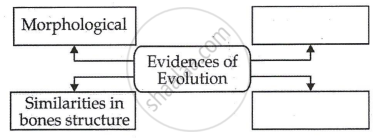Advertisements
Advertisements
प्रश्न
Read the following statement and justify same in your own words with the help of suitable example.
There is evidences of fatal science among chordates.
उत्तर
- It is believed chordates have originated from invertebrates.
- It is difficult to find out from which invertebrate group the chordates were developed.
- Chordate ancestors were soft bodied animals, hence they were not preserved as fossils.
- Thus, there is evidence of fatal science among chordates.
APPEARS IN
संबंधित प्रश्न
Give two examples of vestigial organs in human beings and plants.
With the help of any two suitable examples explain the effect of anthropogenic actions on organic evolution.
Select two pairs from the following which exhibit divergent evolution. Give reasons for your answer.
(i) Forelimbs of cheetah and mammals
(ii) Flippers of dolphins and penguins
(iii) Wings of butterflies and birds
(iv) Forelimbs of whales and mammals
How analogy and homology considered as an evidence in support of evolution ?
Explain the terms analogous and homologous organs with examples.
Attempt giving a clear definition of the term species.
Give the importance of fossil in support of organic evolution
Explain with an example for the given, how the following provides evidence in favor of evolution in organisms :
Fossils
Name two animals having homologous organs and two having analogous organs. Name these organs.
The organs which perform different functions but have the same basic structure are known as :
(a) homologous organs
(b) analogous organs
(c) homolytic organs
(d) analytic organs
Wing of an insect and forelimb of a bird are :
(a) analogous organs
(b) analeptic organs
(c) homologous
(d) homophobic organs
There are five animals A, B, C, D and E. The animal A uses its modified forelimbs for flying. The animal B uses its forelimbs for running whereas the animal C uses its forelimbs for grasping. The animal D can live on land as well as in water and uses its forelimbs to prop up the front end of its body when at rest. The animal E which respires by using spiracles and tracheae uses wings for flying but its wings are analogous to the modified forelimbs of animal A.
(a) What could the animals A, B, C, D and E be?
(b) Why are the forelimbs of animals A, B, C, D called homologous organs?
(c) What does the existence of homologous organs in animals A, B, C and D tell us about their ancestors ?
(d) Why are the modified forelimbs of animal A and the wings of animal E called analogous organs?
(e) State whether animals A and E have a common ancestor or not.
X, Y, and Z are three animals. The animal X can fly but animal Y can only run on ground or walls. The forelimbs of animals X and Y have the same basic design but they are used for different purposes such as flying and running respectively. The animal Z became extinct an long time ago. The study of fossils of Z tells us that it had some features like those of X and some like those of Y. In fact, Z is said to form a connecting link in the evolutionary chain of X and Y.
(a) What could the animals X, Y and Z be?
(b) What name is given to the forelimbs like those of X and Y which have the same basic design but different functions?
(c) Name one feature in which Z resembled X.
(d) Name one feature in which Z resembled Y.
(e) Which is the correct evolutionary chain involving X, Y and Z : X → Z → Y or Y → Z → X?
Write the names of those animals in whom the human body organs are functioning.
Answer the following question.
Wisdom teeth : Vestigial organs :: Lungfish : ....................
Define fossil.
Differentiate between connecting links and the missing links.
Short answer question.
Give the significance of fossils.
The decaying process of C-14 occurs continuously in dead organisms only.
Give scientific reason.
Duck-billed platypus shows relationship with mammals.
Write a short note:
Embryological evidences
Observe the following images and answer the questions.

- Which evolutionary evidences are indicated in the given picture?
- How are they formed?
- Which method is used to measure their age or their time?
Explain any five types of evidence that support the theory of evolution.
Select vestigial organs from the following.
Which of these is not a vestigial organ in human beings?
- Define vestigial organs.
- Write names of any two vestigial organs in the human body.
- Write name of those animals in which these vestigial organs are functional.
Cucurbits do not develop thick and woody stem as they are:
Study of fossils is ______.
Analogous organs arise due to ______.
Give a scientific reason.
Morphological evidences suggest that dog, sheep and wolf have a common origin.
Find odd one out:
Write down the difference between homologous and analogous organs.
Explain natural selection with the example of industrial melanism.
Define the term:
Homologous organs
Complete the following conceptual picture:

Write names of some vestigial organs in the human body.
